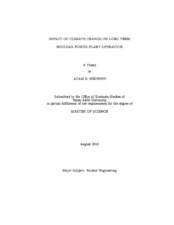| dc.description.abstract | The present work examines the potential impact of changes in climatic conditions
on the long-term functioning of nuclear power plants. Nuclear power plants are
potentially susceptible to changes both in acute risks, such as severe storm events,
and chronic risks, such as detrimental changes in the thermodynamics of plant
operation. Extending plant lifetimes well beyond the lengths of operation for which
they were originally designed suggests the necessity of studying the impacts such
changes might have.
Potential threats are examined in light of earlier work performed by Business
Continuity Consulting on commission for Enteritgy Nuclear. The fourteen risk
drivers identified in that work as threats warranting additional investigation are
studied individually, and their relevance and likely impact extrapolated for regions
covered by the ten selected sites under examination. Thermodynamic eff ects are
simulated with a plant analysis program known as PEPSE (Performance Evaluation
of Plant Systems Efficiencies), with which a broad range of modeled environmental
and plant conditions are analyzed for potential impacts to plant functioning.
Of the fourteen climatic risk drivers considered, changes in drought and
ood severity and frequency resulting from climate change were determined to be the
most likely detriments to plant operations. Precipitation gures indicate that plants
located in the Midwest are particularly susceptible to future drought conditions
while those in the Northeast are likely to experience more frequent
ooding. Many
of the risk drivers specifi ed by the earlier work were only cursorily examined in
light of the complex nature of these phenomena and lack of well defi ned correlation
to climate change. Other risks were analyzed using the gathered data, but were
determined not to pose signi ficant threats to plant operations.
In addition to large scale climatic e ffects, changes related to coolant
uid temperature
rise and plant component efficiency were examined to qualify their e ect
on the thermodynamics of the model plant. Plant operating conditions were modeled
for a wide range of conditions related to theoretical environmental changes.
These examinations showed negligibly small impacts caused by increased coolant
water temperature and moderate impact caused by changes in air humidity. | en |


